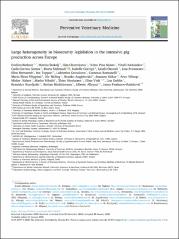Large heterogeneity in biosecurity legislation in the intensive pig production across Europe

View/
Date
2025Author
Biebaut, Evelien
Štukelj, Marina
Chantziaras, Ilias
Pina Nunes, Telmo
Nedosekov, Vitalii
Gomes, Carla Correia
Mehmedi, Blerta
Correge, Isabelle
Ozsvari, Laszlo
Svennesen, Line
Bernaerdt, Elise
Toppari, Ina
Gresakova, Lubomira
Romanelli, Costanza
Filippitzi, Maria Eleni
Meling, Siv
Angjelovski, Branko
Küker, Susanne
Viltrop, Arvo
Đidara, Mislav
Nikolić, Marko
Nicolaisen, Thies
Vink, Eline
Dahlin, Lisa
Kureljušić, Branislav
Baraitareanu, Stelian
Allepuz, Alberto
Prodanov-Radulović, Jasna
Metadata
Show full item recordAbstract
Implementing biosecurity measures in the pig production is crucial to optimize animal health and reduce antimicrobial
usage. A legal framework may help to ensure all stakeholders understand the need of biosecurity
measures and to implement them correctly. Limited knowledge is available about how implementation of biosecurity
measures is regulated in European countries. Therefore, the aim of this study was to identify which
biosecurity measures were mandatory by national legislation and/or by pig sector organizations of European
countries for the intensive pig production under normal circumstances (i.e. no (threat of) disease outbreaks). A
questionnaire including 51 biosecurity measures, 32 on external and 19 on internal, was developed and sent to
national country representatives. Twenty-four European countries, of which 18 belonging to the European
Union, indicated which biosecurity measures were mandatory by law. Four countries, France, Spain, Italy and
Romania had a single national pig-specific biosecurity legislation, while in the other countries multiple legislations
had to be consulted to complete the questionnaire. In general, there was a high heterogeneity in the
number of measures that were mandatory by law per country. Most biosecurity measures addressed in the national
legislation focused on external biosecurity and were measures that can be easily audited when conducting
a farm visit such as the presence of a hygiene lock, fencing around the farm and the existence of documentation.
A significant (p < 0.001) positive correlation was observed between the presence of external and internal biosecurity
measures in the legislation. Yet, no significant association was observed between the number of biosecurity
measures present in the national legislation and the size of the pig production. Fourteen countries
indicated which biosecurity measures were required by pig sector organizations for intensive pig farms. The
median number of biosecurity measures mandatory by pig sector organizations but not by law was 13 with a
minimum of one measure in Germany and a maximum of 24 in Croatia. Different countries apply different
strategies to increase the level of biosecurity. Further research is needed to investigate the impact of the different
strategies on the implementation of biosecurity on intensive pig farms in the countries.
